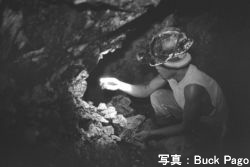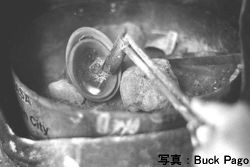Engaging small-scale mining communities in understanding the impact of mercury pollution through sampling of fish, water, and sediments and establish a baseline of mercury pollution in these communities.
 |
Ban Toxics |
 |
Richard Gutierrez |
 |
http://www.bantoxics.org |
 |
JPY 300,000 |

Gold mining

Rid of impurities
Research Background
The Philippines is one of the largest emitters of mercury pollution in the Southeast Asian region through the artisanal and small-scale gold mining (ASGM) sector. The Philippine government estimates that at least 70 metric tonnes of mercury is emitted every year by the ASGM sector (Department of Environment and Natural Resources, 2008). Other experts, however, see this figure as very low, and estimate that 200-500 metric tonnes of mercury as a more realistic level of emissions of mercury from the ASGM sector (Peter Appel, Danish Gelogical Survey Society).
It is ironic that the Philippines is able to emit such high levels of mercury in one sector even if it is not a primary producer of mercury and that it has strict regulations in the use of mercury. All the mercury used by the ASGM sector, comes into the country from outside sources, e.g. United States, Europe, and other developed nations, in general. More often, these mercury come in illegally.
Mercury pollution poses a complex and unique problem for the Philippines. Studies have estimated that from 100,000 to 300,000 families rely on ASGM as a means of livelihood. Thus, banning or simply outlawing mercury use in ASGM will be very difficult due to poverty of most miners. In a country where 25.4 million Filipinos are living below $1.35/day, the lure of gold can be overpowering.
Unless efforts are made to stem the continued mercury pollution generated from the ASGM sector, the prospect of long-term damage to the environment and public health will become a reality.
Civil society has played a key role, so far, in pushing governments to take a more proactive and broader perspective in dealing with mercury pollution. For instance, NGOs have cooperated with the Philippine government to develop a regulation phasing out mercury in all healthcare facilities, and have been instrumental in introducing the concept of terminal storage of mercury wastes in the country. Ban Toxics has played active roles in these two mercury initiatives.
As part of its continuing work on mercury, Ban Toxics will be embarking on helping address mercury use in ASGM by involving small-scale mining communities in understanding the impact of mercury pollution in their communities.
The goal of the study is to establish a baseline of mercury pollution in 6 small-scale mining areas around the Philippines, focusing on water, sediment, and fish. The research will involve training the miners or their families in obtaining samples of the identified media, so that they become aware of the scientific process of sampling, and also be empowered to take future samples for possible future monitoring.
In reaching the above goals, the following methodology will be followed:
1. Collection of Data, which comprises of site and community visits; sampling; research of past studies, and interviews.
2. Preparation and writing of Report, which will involve data analysis and image documentation.
The study aims to affect the following changes in Philippine society:
1. Empower communities in understanding the consequences of mercury use in small-scale mining.
2. Protect the mining and surrounding communities from mercury pollution.
3. Assist government decision makers and other stakeholders in formulating solutions to the plight of small-scale mining.
4. Empower mining communities in using scientific process to measure the mercury pollution they are creating.
In undertaking the study, the proponent aims to use it in the following manner:
1. Present research results at the national level to raise the unique situation of mercury-use in small-scale mining and dangers of elevated mercury pollution levels.
2. Use the research as a model for other communities engage in small-scale mining.
The study term is for 8 months.
[Sep. 2009]
Final Report (abstract)
Artisanal and Small-scale Gold Mining (ASGM) presents a complex development issue. While it provides livelihood to a significant number of people worldwide and accounts for a sizeable volume of annual gold production, it is also confronted with various grave environmental, social and health concerns. The sector is also known as the largest emitter of mercury. The global mercury treaty, which is currently being developed through a series of intergovernmental negotiating committee meetings, seeks to incorporate ASGM elements to reduce, moving towards elimination of mercury use in the sector and to protect human health and the environment. While the terms of the global pact are being considered, parallel efforts are underway to encourage migration of miners to mercury-free gold liberation techniques.
The Philippines is in the process of formulating its National Strategic Plan on ASGM with support from the United Nations Environment Programme (UNEP). To supplement this initiative, Ban Toxics a non-profit environmental non-governmental organization that aims to promote environmental justice, with the help of the Takagi Fund for Citizens Science and that Natural Resources Defense Council, and the Swedish Society for Nature Conservation conducted a study on the inner workings of ASGM focusing, among others, on the trading, use and emission of mercury, gold mining and production methods, and the human health and environmental impacts of mercury pollution. The study was also conducted to verify levels of mercury in their communities, to acquaint grassroots communities such as ASGM miners to the processes used to measure mercury contamination, and understand the social context that prompts ASGM miners to continue using mercury in gold mining.
Mercury release from the ASGM sector in the Philippines is estimated at 70 metric tons per year, making the industry one of the biggest contributors of mercury pollution. In 2006, the United Nations reported that miners in the Philippines are found to have mercury levels up to 50 times above World Health Organization limits. About 18,000 women and children, the sectors most likely to succumb to mercury's toxic threats are also engaged in small-scale gold mining.
The study arrived at the following conclusions:
1. The problem of mercury pollution in the Philippines is widespread and that unless and until urgent and drastic steps are carried out to contain its further discharge into the environment, the effects will be disastrous. It also noted the sector's growing shift from mercury to cyanide and attempts to move to mercury-free gold production technologies.
2. There is no silver bullet that can adequately address the complex issues surrounding ASGM in the Philippines. Care should be taken to understand the specific ASGM areas, the needs of the community and its goals for development be for any effective intervention can take place.
3. Considering these constraints, to rationalize ASGM activities and improve governance of ASGM operations, the following broad strategies, mechanisms and potential solutions to various ASGM concerns may be considered:
A. Stop the global supply flow of mercury by putting an end to primary mining of mercury.
B. Prohibiting the trade and use of mercury and mercury compounds in all sectors.
C. Provide technical support to ASGM in:
i. Exploration and delineation of mineral deposits;
ii.Mineral inventory for extraction at the small-scale level;
iii.Identify areas that can be set aside by the provincial or city mining regulatory boards as People's Small Scale Mining Area; and
iv.Study gold ores properties to determine mercury- free gold liberation techniques
D. Provide needed working capital, credit facilities and suitable mining equipment to ASGM;
E. Organize and strengthen ASGM formal groups to reduce and eventually eliminate exploitation of miners.
F. Develop coherent national policy on mining and streamline regulatory and administrative procedures to remove barriers for formalization.
G. Strengthen local mining regulatory boards.
H. Increase awareness on mercury's toxic effects to miners, theirs families and affected communities.
Ban Toxics also recommends for the government and civil society to initiate a dialogue to find out how and where does ASGM fit into national development. Oftentimes, ASGM is linked with sustainable development, but no concrete consultation with mining and other stakeholders have taken place to define ASGM's role. Currently the serious social, health and environmental costs that accompany small-scale gold mining are externalized and borne by communities and local governments where these operations occur. Any real discussion of the benefits of ASGM and its role in national development must be weighed by these external costs that are often ignored. Particularly, efforts towards internalizing the external costs of gold production must be carried out before we seriously consider mainstreaming ASGM into the national development agenda.
[Feb. 2011]
Others
